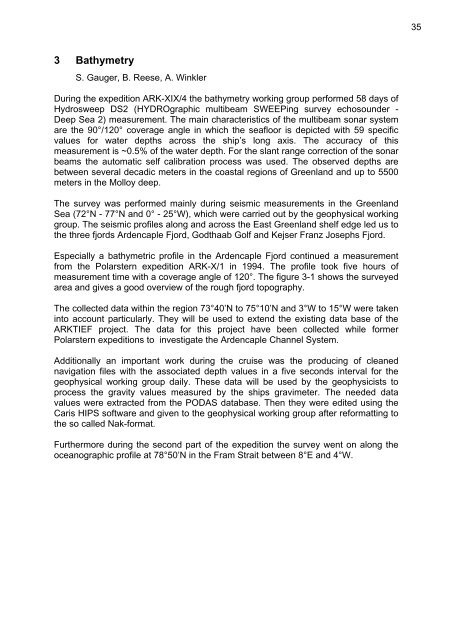the Expedition ARKTIS-XIX/4 of the research vessel POLARSTERN ...
the Expedition ARKTIS-XIX/4 of the research vessel POLARSTERN ...
the Expedition ARKTIS-XIX/4 of the research vessel POLARSTERN ...
You also want an ePaper? Increase the reach of your titles
YUMPU automatically turns print PDFs into web optimized ePapers that Google loves.
3 Bathymetry<br />
S. Gauger, B. Reese, A. Winkler<br />
During <strong>the</strong> expedition ARK-<strong>XIX</strong>/4 <strong>the</strong> bathymetry working group performed 58 days <strong>of</strong><br />
Hydrosweep DS2 (HYDROgraphic multibeam SWEEPing survey echosounder -<br />
Deep Sea 2) measurement. The main characteristics <strong>of</strong> <strong>the</strong> multibeam sonar system<br />
are <strong>the</strong> 90°/120° coverage angle in which <strong>the</strong> seafloor is depicted with 59 specific<br />
values for water depths across <strong>the</strong> ship’s long axis. The accuracy <strong>of</strong> this<br />
measurement is ~0.5% <strong>of</strong> <strong>the</strong> water depth. For <strong>the</strong> slant range correction <strong>of</strong> <strong>the</strong> sonar<br />
beams <strong>the</strong> automatic self calibration process was used. The observed depths are<br />
between several decadic meters in <strong>the</strong> coastal regions <strong>of</strong> Greenland and up to 5500<br />
meters in <strong>the</strong> Molloy deep.<br />
The survey was performed mainly during seismic measurements in <strong>the</strong> Greenland<br />
Sea (72°N - 77°N and 0° - 25°W), which were carried out by <strong>the</strong> geophysical working<br />
group. The seismic pr<strong>of</strong>iles along and across <strong>the</strong> East Greenland shelf edge led us to<br />
<strong>the</strong> three fjords Ardencaple Fjord, Godthaab Golf and Kejser Franz Josephs Fjord.<br />
Especially a bathymetric pr<strong>of</strong>ile in <strong>the</strong> Ardencaple Fjord continued a measurement<br />
from <strong>the</strong> Polarstern expedition ARK-X/1 in 1994. The pr<strong>of</strong>ile took five hours <strong>of</strong><br />
measurement time with a coverage angle <strong>of</strong> 120°. The figure 3-1 shows <strong>the</strong> surveyed<br />
area and gives a good overview <strong>of</strong> <strong>the</strong> rough fjord topography.<br />
The collected data within <strong>the</strong> region 73°40’N to 75°10’N and 3°W to 15°W were taken<br />
into account particularly. They will be used to extend <strong>the</strong> existing data base <strong>of</strong> <strong>the</strong><br />
ARKTIEF project. The data for this project have been collected while former<br />
Polarstern expeditions to investigate <strong>the</strong> Ardencaple Channel System.<br />
Additionally an important work during <strong>the</strong> cruise was <strong>the</strong> producing <strong>of</strong> cleaned<br />
navigation files with <strong>the</strong> associated depth values in a five seconds interval for <strong>the</strong><br />
geophysical working group daily. These data will be used by <strong>the</strong> geophysicists to<br />
process <strong>the</strong> gravity values measured by <strong>the</strong> ships gravimeter. The needed data<br />
values were extracted from <strong>the</strong> PODAS database. Then <strong>the</strong>y were edited using <strong>the</strong><br />
Caris HIPS s<strong>of</strong>tware and given to <strong>the</strong> geophysical working group after reformatting to<br />
<strong>the</strong> so called Nak-format.<br />
Fur<strong>the</strong>rmore during <strong>the</strong> second part <strong>of</strong> <strong>the</strong> expedition <strong>the</strong> survey went on along <strong>the</strong><br />
oceanographic pr<strong>of</strong>ile at 78°50’N in <strong>the</strong> Fram Strait between 8°E and 4°W.<br />
35

















